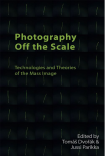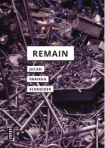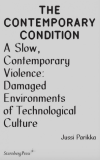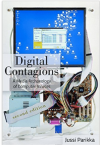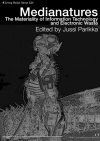Archive
A Lab of Labs
AMT was again part of the Istanbul Design Biennial, this time together with Bilkent University (Ankara) hosting a workshop and a panel. We responded to the main theme of School of Schools with our own emphasis: a lab of labs. In other words, working with the Bilkent Media Archaeology Lab (led by Andreas Treske) we organised a two day event that performed a lab in as a method to investigate it as a assemblage of methods, techniques, affordances of the lab in an urban environment and in the context of Istanbul, a city with a long heritage of crafts, workshops, and design irreducible to a sanitized design thinking discourse.
Benefiting from the experience of Ege Berensel and Başak Altın we engaged in workshopping that included 8 mm found footage (home films) and motherboards (as a source of circuit bending and tinkering). While Ebruk Kurbak joined us to talk about her work in textiles, computing and material methodologies in speculative design, and Tuğçe Karatas shared her views as an independent curator, our special surprise guest was the local TV repair shop expert who gave us a two hour crash course into his work and electronics! The lab includes many kinds of expertise.
The workshop was also part of the research for #TheLabBook – online at What is a Media Lab?.
 Andreas Treske’s opening words, together with Björk’s poetic exploration of the television.
Andreas Treske’s opening words, together with Björk’s poetic exploration of the television.
 Başak Altın and Ege Berensel, artists from Ankara, were part of the work. Here Basak narrating a short visual history of motherboards.
Başak Altın and Ege Berensel, artists from Ankara, were part of the work. Here Basak narrating a short visual history of motherboards.
 An unpicking of a video projector into its material-epistemic components, measurable as objects of interest, unfolding multiple levels of media archaeology. #OfficeTruisms
An unpicking of a video projector into its material-epistemic components, measurable as objects of interest, unfolding multiple levels of media archaeology. #OfficeTruisms

Labs as hands-on practice.

A short introduction to electronics – from the perspective of repairing televisions and other appliances.
What is Media Archaeology? in Turkish
The Turkish translation of What is Media Archaeology? is out this week! Koc University Press are publishing the translation Medya Arkeolojisi Nedir? by Ebru Kılıç and you can order the book and find more information in Turkish online.

I am extremely happy about the translation as well as the fact that it coincides with my Bilkent University visit in Ankara where I am part of the Play/Pause, FF/Rewind-week of events on “Shared Practices & Archaeologies of Media.” The event is part of the launch of the new media archaeological space that colleagues at Bilkent have been working on. The lab will be the first of its kind in Turkey. The week of talks and activities will finish on Friday with a launch of Medya Arkeolojisi Nedir? in Ankara at the Erimtan Arkeoloji ve Sanat Müzesi at 6 pm.
An Istanbul launch of the book is in planning for a later date in the Autumn.
For review copy and other requests regarding the Turkish translation, please get in touch with me or directly with the Press (Berkan Simsek).
The publisher’s page for Medya Arkeolojisi Nedir?
Eski ven Yeninin Kartografileri – a sample from the translation online.
After Arikan: Data Asymmetry
After our succesful exhibition of Burak Arikan’s work, Data Asymmetry, I am posting some of the interviews and material that came out of the exhibition.
Here’s a video interview we did with Arikan setting up the exhibition in the Winchester gallery in November 2016:
And then there’s the interview(s) in Furtherfield: Carleigh Morgan interviewed Burak in the part 1 of the interview about Data Asymmetry and myself in part 2 of the interview. The interview(s) address mapping as a collective experiment, networks as events, (art) methodologies of working with data and a lot of other topics related to internet culture.
A Media Archaeology of Ingenious Designs
The Istanbul Design Biennial launches this week and we are glad to announce to be one of the invited participants. Our project with Ayhan Ayteş on the Middle-East legacy of technology and design is exhibited in the Studio X space. Besides featuring objects from this particular historical period of approximately 800-1200, the idea is to make this heritage enter into a conversation with speculative design, an alternative geopolitics of technology and imaginaries of design and media. This is executed in the form of seminar with Laura Marks and Azadeh Emadi (19th of November) and a workshop (November 20) on the design fictions and media archaeological imaginations of past futures, and imaginary realities of Middle East and technology. A lot of our thinking behind this programme has been influenced by the Variantology-project (Siegfried Zielinski et al).

The Elephant Clock, from The Book of Knowledge of Ingenious Devices (1206), (Topkapi Sarayi Library, Ahmet III, Ms. 3472)
Below is the short text we wrote for the catalogue of the Istanbul Design Biennial.
Jussi Parikka and Ayhan Aytes
A Media Archaeology of Ingenious Designs
Modern European culture has positioned early mechanical clockworks as key contraptions and symbols of the machine age of industrialism, later computer culture, and of the old new media of visual technologies (microscopes, telescopes and more). European humanism prescribed a mastery over technological culture while building automata as luxury machines intended to amuse and awe. This technological culture also resulted in questions about what the human is. But answering the question are we human? necessitates the further questions of when are we human, and where are we human?
When instead then? What if you start this story in an alternative fashion, in a different time and at a different place? What if you start with a speculative mind-set relating to existing but often forgotten histories of the design of the human and its doubles: technologies of automata and of the measurement of the world, alternative cosmologies in which advanced media machines are born as part of Muslim culture?
An alternative modernity: Baghdad since the ninth century and the Bayt-al-Hikma (House of Wisdom) supported by caliphs and their viziers as a special place of scientific knowledge. Nowadays we would call this an interdisciplinary laboratory for science, design and technology. Translations of texts and an enthusiastic interest in mathematics, logic, medicine and other sciences mix with innovations in design. A world of musical automata that work instead of humans; design prototypes for various machines that reach a sort of apex in Al-Jazari’s celebrated Book of Knowledge of Ingenious Mechanical Devices (1206), which functions not only as a historical source on this rich culture of invention but also as a speculative design manual for an alternative technological culture.
In The Difference Engine, their 1990 science fiction novel, Bruce Sterling and William Gibson pitched a similar sort of idea relating to 19th century Victorian culture as part of a steampunk imaginary: what if the modern age of computation had already started then, a hundred years earlier than thought? Rewind further back in time: What if the age of programmable machines and advanced technologies could be said to have started in the “Arab-Islamic Renaissance” of 800-1200? We could then look at early devices like astrolabes as instruments of planetary design that mediate an understanding of the positions of the sun and the stars in relation to human practices such as prayer times. Besides technologies of time and location needed for the structure of everyday religion, programmable machines functioned as prototypes for computing by way not only of Muḥammad ibn Mūsā al-Khwārizmī’s “algorithm” but also the The Banū Mūsā brothers’ programmable musical machine.
Such examples beg us to alter our historical focus to a different age and a different region. Automata mirror and deflect, distort and circulate as machines of imaginary and real extensions of the supposedly human. They also question how human practices can be automated in the uncanny lives of technological artefacts. Automata are machines that situate questions of the human and its others as part of a deep-time media archaeology of robots and automata, and alternative geographies of design culture. Ask what the human is, and you also implicitly ask: what is not human, what is just about human, and what is barely human.
Sources:
Marks, Laura, Enfoldment and Infinity. An Islamic Genealogy of New Media Art (Cambridge, MA: The MIT Press, 2010).
Nadarajan, Gunalan “Islamic Automation: A Reading of Al-Jazari’s The Book of Knowledge of Ingenious Mechanical Devices (1206) “ in MediaArtHistories, ed. Oliver Grau (Cambridge, MA: The MIT Press, 2007), 163–78.
Zielinski, Siegfried and Peter Weibel (eds.), Allah’s Automata. Artifacts of the Arab-Islamic Renaissance (800-1200). (Berlin: Hatje Cantz, 2015).

Water Serving Automaton,The Book of Knowledge of Ingenious Devices (1206) (Topkapi Sarayi Libray, Ahmet III, Ms. 3472).

Earwitnesses of a Coup Night
Update: This text is published inGerman in the Zeitschrift für Medienwissenschaft‘s blog, translated by Florian Sprenger. It is also published in Turkish in Biamag, translated by Doğan Terzi. Here is the original English version, which is also published on the Theory, Culture & Society journal’s blog.
Earwitnesses of a Coup Night: The Many Media Infrastructures of Social Action
The particularly cruel scenes in Ankara and Istanbul from July 15th and 16th circulated quickly. From eye witness accounts to images detached from their context, media users, viewers and readers was soon seeing the graphic depictions of what had happened with the added gory details, some of them fake, some of them not.
Still and moving images from the hundreds of streams that conveyed a live account of the events left many in Turkey puzzled as to what is going on. Only later most were able to form some sort of a picture of the events with the coherence of a narrative structure. By the morning the live stream on television showed military uniform soldiers raising their hands and climbing down from their tanks. What soon ensued were the by already now iconic images of public punishment: the man with his upper torso bare and the belt as his whip, the stripped soldiers in rows shamed and followed up by the series of images of expressions of collective joy as most of Turkey was relieved again. The coup was over. The unity in resisting the coup was unique. As it was summarised by many commentators: even the ones critical of the governing AK Party’s politics agreed that this was not a suitable manner of overthrowing an elected government.
However, what became evident immediately in the wake of the actual events was the quick spread of narratives and explanations about the coup night and its extent. As one journalist aptly and with a healthy dose of sarcasm put it:

The flux of commentaries on social media and in newspapers, columns and television deserved its own name: “coupsplaining” as @shokufeyesib coined it.
Also some rather established organisations like Wikileaks got quickly on the spectacle-seeking bandwagon of the coup attempt’s repercussions. Turkish journalists and activist soon read and revealed that the so-called “AKPleaks”-documents were not really anything that interesting as it was advertised to be. As Zeynep Tufekci summarised: “According to the collective searching capacity of long-term activists and journalists in Turkey, none of the ‘Erdogan emails’ appear to be emails actually from Erdogan or his inner circle” while actually containing information that could be considered harmful to normal Turkish citizens instead.
Of course, besides commentators inside and outside Turkey, there was no lack of people with first-hand experience. Besides the usual questions that eyewitnesses were asked in many news reports about “how did things look like”, another angle was as pertinent. How did it sound? The soundscape of the coup was itself a spectacle catered to many senses: the helicopters hovering around the city; the different calibre gunfire that ranged from heavy fire from helicopters to individual pistol shots; individual explosions; car horns; sirens, and the roaring F-16 that descended at times so low so that its sonic boom broke windows of flats. Such sonic booms have their own grim history as part of the 21st century sonic warfare as cultural theorist Steve Goodman analysed the relation of modern technologies, war and aesthetics. As has been reported for years, for example Israeli military has used sonic noise of military jets in Palestine as a shock technique: “Palestinians liken the sound to an earthquake or huge bomb. They describe the effect as being hit by a wall of air that is painful on the ears, sometimes causing nosebleeds and ‘leaving you shaking inside’.”
In the midst of sonic booms, a different layer of sound was felt through the city: the mosques starting their extraordinary call to prayer and calls to gather on the streets. The latter aspect was itself triggered by multiple mediations that contributed to the mobilization of the masses. Turkish President had managed to Facetime with CNN-Turk’s live broadcast and to call his supporters to go on the streets to oppose the coup attempt. By now even the phone the commentator held has become a celebrity object with apparently even $250,000 offered for it.
But there was more to the call than the ringtone of an individual smartphone. In other words, the chain of media triggers ranged from the corporate digital videotelephony to television broadcasting to the infrastructures of the mosques to people on the streets tweeting, filming, messaging and posting on social media. All of this formed a sort of a feedback-looped sphere of information and speculation, of action and messaging, of rumours and witnessing. Hence, there was more than just traditional broadcast or digital communication that made up the media reality of this particular event.
The mosques started to amplify the political leadership’s social media call by their own acoustic means. Another network than just social media was as essential and it also proved to be irreducible to what some called the “cyberweapon” of online communications. As one commentator tried to argue commenting on the events in Turkey: “But, this is the era of cyberpower. Simply taking over the TV stations is not enough. The Internet is a more powerful means of communication than TV, and it is more resilient — especially with a sophisticated population.” However, there were also other elements in the mix that made it a more interesting and a more complex issue than merely about the “cyber”.
Turkish artist and technologist Burak Arikan had already in his earlier work mapped the urban infrastructure of Istanbul in terms of its mosques, malls and national monuments. “Islam, Republic, Neoliberalism” (2012) employs his critical mapping methodology to visualise how structures of power are part of the everyday whether we always realise these relationships or not. Based on his research, Arikan devised three maps of those architectural forms and how they connect. According to Arikan, the “maps present a comparative display of network patterns that are formed through associations linking those architectural structures that represent the three dominant ideologies –Islam, Republic, Neoliberalism– in Turkey.”
During the coup weekend, it was the network of the mosques and their minarets that became suddenly very visible – or actually, very audible. While the regular praying times have become such an aural infrastructure of the city that one does not necessarily consciously notice it, the extraordinary calls from imams reminded how dense this social, architectural fabric actually is. The thousands of Istanbul mosques became itself an explicit “sonic social network” where the average estimated reach (300 meters) of sound from the minarets is too important of a detail to neglect when one wants to understand architecture as solidifying social networks in contemporary Turkey. In the context of mid-July it was one crucial relay of communication between the private sphere in homes, the streets and the online platforms contributing to the mobilization of the masses. The musicological perspective has highlighted how sound and noise negotiate conflict across private and the public and we can extend this to a wider media ecological perspective too. This is where art and design practices can have an instrumental role to play in helping us to understand such overlapped media and sensorial realities.
Artists such as Arikan have investigated the ways how online tools and digital forms of mapping can connect to issues of urban planning and change. The visual artwork helps us to also understand how there are other social realities, less front of our eyes even if they are in our ears. This expands the wider sense of how media is and was involved in Turkey’s events, and it gives also insights to new methodologies of artistic intervention in understanding the coupling of media, architecture, visual methods and the sonic reality of urban life. And in this case of the bloody events of the coup weekend, much of the personal experience of “what happened” is now being narrated in Turkey in terms of what it sounded like – another aspect of the media reality of the coup attempt’s aftermath.
TOKI-town
Istanbul is most often commented for its stunning beauty in a manner that approaches a modern touristic version of orientalism. For sure it is stunning, but the other side of Istanbul, as real but less visible, is the barbed wire protecting upper middle class & luxury housing areas, security cameras, traffic queues, and TOKIs. Indeed, urban planning and Istanbul is such a rich case study not merely if one is interested in Turkey but global capitalism and megacities in general.
To quote a recent MoMA-exhibition Uneven Growth:
“TOKI development parallels the emergence of a new middle class in Istanbul for whom a TOKI flat is part of a dream of car and house ownership, even if this brings social isolation, long hours in traffic, and long-term debt.”
 (Image from Moma/Uneven Growth.)
(Image from Moma/Uneven Growth.)
Google DNS Freedom Fight: 8.8.8.8
In the midst of the past (less than) 24 hours of Turkey’s Twitter-blockade, we have seen a flood of tweets, comments, analysis and information – a lot of them, paradoxically, from Turkey. Some operators might not have yet been quick enough to shut down access, and at the same time people have found access via alternative means. The situation has again meant an increase in people’s understanding of the internet and looking into how DNS works as well as VPN’s. Indeed, tips were spread online to assist Turkish people – such as the three simple methods. And information was passed offline too – demonstration of a yet another connection of the streets and the online.
 That people are able to bypass the DNS-based censorship is one thing to ponder about – especially because the new internet law in Turkey would allow other measures too. But what Geraldine Juárez pointed out on Twitter was of course this: 8.8.8.8. points to Google Public DNS. Corporate freedom services, the rhetorics of net freedom, etc. play as part of this wider scenario where alternatives to authoritarian nationalist politics seem to be the Corporate system. And that it’s pretty odd/scary/eerie that this gets rather automatically picked up as the political alternative, even to the extent of Google becoming infrastructurally used as the politically “open alternative” – or just more bluntly, as “Freedom”:
That people are able to bypass the DNS-based censorship is one thing to ponder about – especially because the new internet law in Turkey would allow other measures too. But what Geraldine Juárez pointed out on Twitter was of course this: 8.8.8.8. points to Google Public DNS. Corporate freedom services, the rhetorics of net freedom, etc. play as part of this wider scenario where alternatives to authoritarian nationalist politics seem to be the Corporate system. And that it’s pretty odd/scary/eerie that this gets rather automatically picked up as the political alternative, even to the extent of Google becoming infrastructurally used as the politically “open alternative” – or just more bluntly, as “Freedom”:
In such situations, one does need quick and dirty solutions – infrastructural affordances, whether corporate or not, need to be taken into use for short-term goals; but in terms of the wider political situation of networks – networkpolitics on the level where infrastructure meets the political imaginary – this leads into rather an odd choice between “closed” and “open” that does not imply as clear of a choice as one would assume based on the older political vocabularies. This is indeed not to downplay the significance of this sort of activism – distributing DNS information on streets, as in the image below. It is just to ask the fundamental questions regarding political choice, alternatives and how much the lack of alternatives is increasingly attempted to be hardwired into a material actualisation of the lack of political imaginary: “no choice but”.
Update [March 22, 2014]: Turkish government has now blocked access to Google Public DNS too.
– related reading includes (of course)
Evgeni Morozov’s analysis of network politics and its relation to Silicon Valley but also Benjamin Bratton’s work on “the stack” and the changing political nomos in the age of planetary computation.
Understanding Media: McLuhan 50 years Later
The new issue of Journal of Visual Culture is a celebration of Marshall McLuhan. The Canadian media theorist’s classic book, Understanding Media: Extensions of Man, was published 50 years ago and editor Raiford Guins asked several writers to remember the book with a very short text. The texts in the issue are reactions, variations, recollections and remediations of McLuhan and his themes.
My own text (pp.91-93) was written in Istanbul: a short variation on McLuhan, urban space, weaponization and media environments.
Jussi Parikka: “McLuhan at Taksim Square”
I was carrying a fresh copy of Understanding Media with me on Istiklal Street, Istanbul, alongside people in gas masks and police in riot gear. It no longer felt relevant to write about past experiences of engaging with the book or to reflect on McLuhan as a forerunner of media archaeology. This time I did not want to write about ‘anti-McLuhan’ minor histories of media technologies: the ones that do not take media as extensions of Man but as extensions of the animal – for instance, insects – as their starting point (Parikka, 2010).
Travelling from the Anatolian side of Istanbul with a ferry to Kabatas, the chapter on ‘Weapons’ seemed to strike a chord. Extensive tear-gassing and police operations had turned some parts of the city into something unrecognizable, like in a state of emergency. The events at Gezi Park and its occupation grew from an environmental protest to widespread demonstrations across Turkey. Besides the environmental context, the demonstrations were against the authoritarian measures of the state: excessive tear-gassing, random arrests, and persecution of journalists, spokesmen and – women. In the light of McLuhan one starts to think about the various cultural techniques and media contexts of the events in Istanbul. The usual suspects – social media such as Twitter – were quickly acknowledged as important platforms of knowledge sharing but also for a circulation of the affects of outrage, disbelief and defiance. Online media services seemed to quickly open up a new forum for political discussion, crystallized in the inventive use of hashtags as forms of software literacy. When the mainstream media were airing documentaries on penguins, tweets from Gezi were distributing a whole different set of images about what was happening to public space in Turkey. Tear gas produced its own eerie atmosphere on the streets of Istanbul, which had quickly transformed into policed spaces accessible only with gas masks: a denial of the breath (Sloterdijk, 2009).
Walking up from Kabatas port towards Taksim, one could observe this sort of expansion of the meaning of media. This is where McLuhan is at his best. Media are not only about cinema, television, and radio. We start to see the world as media in itself: roads and surfaces, windows and squares become ways of mediating our relation to time and space. Walls are painted with ad hoc slogans; sprayed with images and words in order to mark a territory but also to leave a trace for the next passerby. The huge letters ‘GAZDOGAN’ referred to the prime minister Tayyip Erdogan and the tear-gas tactics of the government. Not only Facebook walls, but the city walls became quick and dirty media surfaces: I was struck by a photograph of an older Turkish man, in his 70s, drawing the face of Mustafa Kemal Atatürk on the wall. Then he walked to another street corner and drew another face of Mustafa Kemal. It was Kemal who introduced the Latin-based alphabet to Turkey in the 1920s and 1930s: in addition to a Europeanization of Turkey as a way to detach from the writing systems of Arabic and Persian origins, it was also ‘modernization’ in relation to the media technologies of telegraphy and the printing press to which the discrete nature was better suited. The alphabet escorts both a geopolitical orientation as well as entertains a relation to various technological changes not without an effect on our perceptual dispositions.
Atatürk persists as a symbolic reference point for various nationalist protestors: his political heritage nature is remediated as content of chants and demands of political nature. The visual space is not only about figures of Atatürk but also more carnevalistic: penguins (as a reference to mainstream media censorship) are suddenly as popular a source of remix and memes as cats usually are in internet culture. Political expression takes the form of artistic expression: ‘the artist must ever play and experiment with new means of arranging experience, even though the majority of his audience may prefer to remain fixed in their old perceptual attitudes’, writes McLuhan (2001: 276) in the chapter on the telegraph.
The online and the city are paired up in this production of visual resistance, but let’s not get too focused on content. One is struck by McLuhan’s reminder that ‘the city, itself, is traditionally a military weapon, and is a collective shield or armor plate, an extension of the castle of our very skins’ (p. 374). This idea is informative of the role of security, war and the city, but it also misses the point about the past years of security regimes which turn the city into an autoimmune disorder: the inhabitants become the targets of police forces, in relation to global events such as G8/G20 meetings (Renzi and Elmer, 2012), as well as such events as those in Turkish cities. But this autoimmune disease of the city does not extend the skin, but attacks the respiratory organs of people with tear gas. It burns the skin when the chemicals are infused with the water in water cannons. McLuhan is constantly useful as a reminder that media are everywhere, and are able to lock our senses in particular ways – perhaps not in the way that there would be always one dominating media episteme, such as literacy (cf. McLuhan, 2001: 373), but more temporarily as a form of attention management. Instead, there is a constant contestation as to the forms of media power: mainstream television might be producing visions of coldness, like documentaries about penguins, but that feeds back to remediations that expand the time and space of what we mean by media itself.
References
Renzi A and Elmer G (2012) Infrastructure critical: Sacrifice at Toronto’s G8/G20
Conference. Winnipeg: Arbeiter Ring.
McLuhan M (2001[1964]) Understanding Media. London: Routledge.
Parikka J (2010) Insect Media: An Archaeology of Animals and Technology. Minneapolis: University of Minnesota Press.
Sloterdijk P (2009) Terror from the Air, trans. A Patton and S Corcoran. Los Angeles: Semiotext(e).
Photochemical Smog as New Media
Perhaps photochemical smog is the only true new visual media of post World War II technological culture. It represents the high achievements in science and technology, combined with (synthetic) chemistry and sunlight. It modulates the light like advanced visual media should and embeds us in its augmented reality as we suck it into our lungs.
 It encapsulates the mediatic cities of Los Angeles and Beijing, as encompassing surely as Hollywood’s machinery. Just like the material basis of technical media of more conventional kind – such as photography and film – it is chemical based. It is media the same as any photochemical process is about how light gets absorbed on our planet’s atoms and molecules.
It encapsulates the mediatic cities of Los Angeles and Beijing, as encompassing surely as Hollywood’s machinery. Just like the material basis of technical media of more conventional kind – such as photography and film – it is chemical based. It is media the same as any photochemical process is about how light gets absorbed on our planet’s atoms and molecules.
But it’s new media, particular to the modern industrial age and the chemical reactions of more recent history. It feeds of industrial pollution and modern transport. It is about the screen as well – how the sunlight is offered this massive living chemical molecular screen on which to project its energetic images. A molecular aesthetics of an ecology of a dying planet.
Preempting Dissent in Istanbul
We (as in Winchester School of Art) are supporting a screening of Preempting Dissent in Istanbul, at SALT (November 28, at 20.00). This is the first screening in Turkey.
The new documentary is based on the book of same name by Greg Elmer and Andy Opel. The documentary is best described as “a culmination of a collaborative process of soliciting, collecting and editing together video, still images, and creative commons music files from people around the world. Preempting Dissent interrogates the expansion of the so-called ‘Miami-Model’ of protest policing, a set of strategies developed in the wake of 9/11 to preempt forms of mass protest at major events in the US and worldwide.”
The screening is one of the activities that Winchester School of Art is supporting and organizing in Istanbul currently.
Following the screening in the Walk-in Cinema there will be a Q&A with Greg Elmer and myself. The Q&A will be held in English.
More info on the Facebook page of the event.
A teaser trailer of the documentary.












